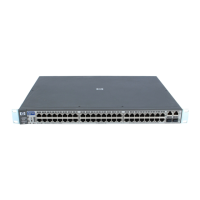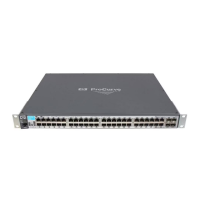Port Trunking
Port Status and Configuration
ProCurve(config)# int a17 lacp passive
Error configuring port A17: LACP and port security cannot be run together.
To restore LACP to the port, you must remove port security and re-enable
LACP active or passive.
Changing Trunking Methods. To convert a trunk from static to dynamic,
you must first eliminate the static trunk.
Static LACP Trunks. Where a port is configured for LACP (Active or
Passive), but does not belong to an existing trunk group, you can add that port
to a static trunk. Doing so disables dynamic LACP on that port, which means
you must manually configure both ends of the trunk.
Dynamic LACP Trunks. You can configure a port for LACP-active or LACP-
passive, but on a dynamic LACP trunk you cannot configure the other options
that you can on static trunks. If you want to manually configure a trunk, use
the trunk command. (Refer to “Using the CLI To Configure a Static or Dynamic
Trunk Group” on page 12-12.)
VLANs and Dynamic LACP. A dynamic LACP trunk operates only in the
default VLAN (unless you have enabled GVRP on the switch and use Forbid to
prevent the ports from joining the default VLAN).
■ If you want to use LACP for a trunk on a non-default VLAN and GVRP is
disabled, configure the trunk as a static trunk.
■ If there are ports that you do not want on the default VLAN, ensure that
they cannot become dynamic LACP trunk members. Otherwise a traffic
loop can unexpectedly occur. For example:
VLAN-1
(Default
VLAN)
VLAN-2
VLAN-1
(Default
VLAN)
VLAN-2
VLAN-1
(Default
VLAN)
VLAN-2
VLAN-1
(Default
VLAN)
VLAN-2
If the ports in VLAN 2 are configured to allow a dynamic trunk (and GVRP is disabled), adding a
second link in VLAN 2 automatically forms a dynamic LACP trunk and moves the trunk to VLAN-1
(the default VLAN), which creates a traffic loop in VLAN 1 between the two switches and
eliminates the link in VLAN 2 between the two switches.
Figure 12-8. A Dynamic LACP Trunk Forming in a VLAN Can Cause a Traffic Loop
12-20
